Fertilisers for Venezuela - Ferrostaal
Fertilisers for Venezuela - Ferrostaal
Fertilisers for Venezuela - Ferrostaal
Create successful ePaper yourself
Turn your PDF publications into a flip-book with our unique Google optimized e-Paper software.
Morón<br />
32<br />
0 10 km<br />
ProjECtS<br />
<strong>Fertilisers</strong> <strong>for</strong> <strong>Venezuela</strong><br />
In June 2007, the state-owned customer Petroquímica de <strong>Venezuela</strong> (PEQUI-<br />
VEN) awarded international firms, including the <strong>Ferrostaal</strong> Group, orders <strong>for</strong><br />
the construction of a petrochemical plant <strong>for</strong> fertiliser production. The total<br />
investment volume <strong>for</strong> the whole complex is about one billion euros. The<br />
<strong>Ferrostaal</strong> Group’s share covers the turnkey construction of the ammonia<br />
plant in the complex.<br />
Valencia<br />
Gulf of Mexico<br />
Lake Valencia<br />
VENEzUELA<br />
Maracay<br />
Camatagua reservoir<br />
Caracas
THE ECHO August 2010<br />
Status of the assembly work on the site of the ammonia plant in March 2010<br />
The petrochemical plant <strong>for</strong> the manufacture of fertilisers<br />
is being constructed in <strong>Venezuela</strong>, in the state<br />
of Carabobo, or, to be more exact, in the small town<br />
of Morón on the Caribbean coast. There is already an old<br />
fertiliser factory operated by PEQUIVEN on the site and<br />
this is to be replaced by the new, modern and efficient<br />
plant. The <strong>Ferrostaal</strong> Group is responsible <strong>for</strong> the ammonia<br />
plant, the Japanese Toyo Group <strong>for</strong> the connected urea<br />
plant and the <strong>Venezuela</strong>n firm Y&V Ingeniería y Construcciones<br />
<strong>for</strong> the ancillary installations. <strong>Ferrostaal</strong> is the commercial<br />
coordinator of this group (THE ECHO December<br />
2007). The assembly work <strong>for</strong> the ammonia plant is carried<br />
out by MCM Construcciones y Montajes, a 100-percent<br />
<strong>Ferrostaal</strong> subsidiary.<br />
The ammonia plant will produce 1,800 metric tonnes of<br />
ammonia per day and the urea plant, 2,200 metric tonnes<br />
of fertiliser granulate. “The model <strong>for</strong> the ammonia plant<br />
is a plant in Trinidad and Tobago, the construction of which<br />
was completed by <strong>Ferrostaal</strong> in August 2004,” says Adalbert<br />
Graff, Head of the Petrochemical Industry business unit at<br />
<strong>Ferrostaal</strong>. “Thanks to the identical design and our decades<br />
of success in the construction of petrochemical complexes,<br />
we have been able to hold our own successfully in international<br />
competition. The impressive per<strong>for</strong>mance of the<br />
plant on Trinidad also helped to convince the customer.”<br />
Fast construction progress in spite of setbacks<br />
The assembly progressed in leaps and bounds. By March<br />
2010, 87 percent of the entire petrochemical complex had<br />
33
34<br />
ProjECtS<br />
been completed. Large components <strong>for</strong> the ammonia plant,<br />
such as the synthesis converter and the CO2 stripper, were<br />
installed at the end of 2009. For the transport of these components<br />
to the site, a sea-ramp had to be specially built off<br />
Morón because although the road between the actual destination<br />
port in Puerto Cabello and the site was well constructed,<br />
it was nevertheless unsuitable <strong>for</strong> these huge<br />
loads (more on page 36). By April 2010, the main items of<br />
equipment, including stripper, CO2 absorber, chiller, all<br />
converters and the steel construction and pipe bridges had<br />
been almost completely installed. “In spite of heavy rains<br />
and interruptions to the work because of local power supply<br />
problems, as things stand, we shall be able to commission<br />
the ammonia plant punctually, within the budget and<br />
to the required quality in April 2011,” says Klaus Scherzer,<br />
Site Manager in Morón. As Site Manager, Mr Scherzer is re-<br />
sponsible <strong>for</strong> the completion of the plant and <strong>for</strong> compliance<br />
with HSE standards on the site.<br />
At present, the MCM team is working flat out, installing the<br />
pipelines, the electrical system and the measurement and<br />
control technology. “About 900 people are making sure<br />
that, day by day, the ammonia plant gets nearer to completion,”<br />
says Mr Scherzer. “There are currently about 2,500<br />
employees working on the whole complex site, most of<br />
these being local employees.” The next steps will be the<br />
preparation of the training units (simulator, classroom and<br />
host plant training) <strong>for</strong> PEQUIVEN’s operating and maintenance<br />
personnel and the commissioning activities. The latter<br />
will start in mid-2010 and will last about ten months<br />
until the provisional acceptance.
THE ECHO August 2010<br />
As the demand <strong>for</strong> foodstuffs and animal feed steadily rises, so does the demand <strong>for</strong> fertilisers.<br />
Completion of the urea plant is planned <strong>for</strong> May 2011. The<br />
whole petrochemical complex <strong>for</strong> the production of fertilisers<br />
is then due to be handed over to PEQUIVEN in June 2011.<br />
Growing demand <strong>for</strong> fertilisers<br />
The long-term aim of the <strong>Venezuela</strong>n government is to develop<br />
the country into one of the leading fertiliser producers<br />
in Latin America. According to the International Ferti-<br />
liser Industry Association, the demand <strong>for</strong> fertilisers in Latin<br />
America from 2010 will grow annually by 2.7 percent and,<br />
over the next five years, a 15 percent share in the growth of<br />
world fertiliser consumption is predicted <strong>for</strong> this region.<br />
The petrochemical complex in Morón, however, is primarily<br />
intended to help make <strong>Venezuela</strong>n agriculture independent<br />
of fertiliser imports.<br />
The rising demand <strong>for</strong> foodstuffs and animal feed is leading<br />
to a continual increase in the use of fertilisers in agriculture.<br />
The faster the population grows, the greater the demand<br />
<strong>for</strong> food and, correspondingly, the more has to be<br />
grown. Rising prosperity in many countries is also leading<br />
to increased consumption of meat by large sections of the<br />
population, so animal feed plants have to be grown intensively.<br />
In comparison with the production of vegetable<br />
food, ten times as much animal feed has to be grown <strong>for</strong><br />
meat production. On top of this, there is a trend which has<br />
become more noticeable in recent years: It is estimated that<br />
as much as 27 percent of the fertilisers produced worldwide<br />
<strong>for</strong> plant cultivation in 2010 will be used <strong>for</strong> the production<br />
of biofuels.<br />
More in<strong>for</strong>mation about <strong>Ferrostaal</strong> in <strong>Venezuela</strong>:<br />
www.ferrostaal.com.ve<br />
The petrochemical complex <strong>for</strong> the production of fertilisers is due to be<br />
handed over to the customer in June 2011.<br />
35
36<br />
ProjECtS<br />
Spectacular heavy transport<br />
Every large industrial plant includes oversize and heavyweight components –<br />
and Morón, in <strong>Venezuela</strong>, is no exception. During the tender phase <strong>for</strong> construction<br />
of an ammonia plant <strong>for</strong> the state-owned customer PEQUIVEN, however,<br />
a major problem arose. Some components to be transported from the destination<br />
port to the construction site would be much too bulky <strong>for</strong> the road along<br />
the coast. Was the whole project to fall at this hurdle? Read how the <strong>Ferrostaal</strong><br />
engineers overcame this problem.
THE ECHO August 2010<br />
Only 35 kilometres of road separate the Caribbean<br />
port of Puerto Cabello from the point on the coast<br />
where a petrochemical complex <strong>for</strong> the manufacture<br />
of fertiliser is being constructed in Morón. This port<br />
is the project’s gateway to the world, as it is where the<br />
imported plant materials and equipment are landed. For<br />
the construction of the ammonia plant alone, ten overdimensional<br />
cargos (ODC) are proposed. For this purpose,<br />
the well-developed coastal road connecting the docks and<br />
the site has to be examined in detail. Will the cargo convoy<br />
get through the gaps? Is the road wide enough at all<br />
points? Are the components too heavy? Initial fears are<br />
confirmed by the study of the route – the road is out of<br />
the question <strong>for</strong> at least two of the ODCs. There is no way<br />
a 450-tonne synthesis converter and a 72-metre-long CO2<br />
stripper can be transported along the road. But the components<br />
have to get to the ammonia plant under construction<br />
punctually and undamaged in order to be installed in<br />
line with the time schedule.<br />
Off to new shores<br />
The painstaking analysis confirms it: The transportation<br />
will have to be carried out by sea. The calculations by the<br />
<strong>Ferrostaal</strong> engineers show that the shipment can only be<br />
delivered on time using the sea route from the port of<br />
Puerto Cabello to the site, about eleven nautical miles<br />
away. But the team first has to create the right conditions<br />
on the coast near Morón to enable the components to be<br />
landed. For this purpose, a subcontractor is appointed to<br />
build a massive stone transport ramp into the sea directly<br />
in front of the site. Studies show that the ramp must<br />
have a total length of 130 metres and a width of ten metres,<br />
so that the head of the ramp can reach a minimum<br />
water depth of 2.2 metres. This is because of the shallow<br />
water, a typical feature of the Caribbean. And even with a<br />
ramp this long, a shallow draught barge has to be found to<br />
make it possible <strong>for</strong> the heavy components to be landed on<br />
the ramp using the Ro-Ro (roll-on/roll-off) system.<br />
37
38<br />
ProjECtS<br />
Unexpectedly, the partner originally planned <strong>for</strong> construction<br />
of the ramp is no longer available. Then, in September<br />
2008, <strong>Ferrostaal</strong> appoints an experienced, but small, local<br />
building firm. Eleven months pass from the initial planning<br />
and procurement of the environmental and construction<br />
permit to the completion at the end of August 2009.<br />
The perils of the sea<br />
The project team is confronted by changing depth conditions<br />
off the ramp. A wandering sandbank threatens to prevent<br />
the docking of the barge. The team has to monitor the<br />
depth conditions off the head of the ramp through continuous<br />
measuring. Local divers assist in these activities<br />
and examine the seabed <strong>for</strong> obstructions in the navigation<br />
channel.<br />
Meanwhile, another challenge reveals itself: the search <strong>for</strong><br />
a suitable, self-propelled, ocean-going barge. This has to<br />
meet the requirement <strong>for</strong> a shallow draught and have the<br />
necessary load capacity. Either a <strong>Venezuela</strong>n or a <strong>for</strong>eign<br />
barge has to be found. The latter, however, would need a<br />
permit <strong>for</strong> sailing from one port to another in <strong>Venezuela</strong>n<br />
waters, and this could be very time-consuming. In their<br />
search <strong>for</strong> a suitable barge, the <strong>Ferrostaal</strong> team checks all<br />
the possibilities in South America – from the Amazon in<br />
Brazil to the Orinoco in <strong>Venezuela</strong>. The choice is not great<br />
and all the barges in question are already in use. Finally,<br />
they charter a suitable vessel from Panama, but its bow<br />
ramp has to be widened by three metres to load the widest<br />
piece of equipment. The local team has managed, just in<br />
time, to get the permits from the port authority <strong>for</strong> use of<br />
the ramp. But these are only temporary – the ramp will<br />
have to be removed again be<strong>for</strong>e the project is completed.
THE ECHO August 2010<br />
Heavy parts from Europe<br />
In October 2009 the moment has finally arrived: The<br />
450-tonne synthesis converter and the huge CO2 stripper<br />
are at last collected by the barge from their temporary storage<br />
in the port of Puerto Cabello. They had been transported<br />
from Europe to the port of Puerto Cabello on a big-lift<br />
vessel specially chartered <strong>for</strong> this purpose. The dimensions<br />
are impressive: the converter measures 32 metres in length<br />
and, including low-loader, is 8.5 metres wide. The CO2 stripper<br />
meanwhile is 72 metres long and, including low-loader,<br />
6.5 metres wide. During the loading of the barge, which<br />
looks flimsy in comparison with the ocean-going vessel, the<br />
project team holds their breath. But everything goes<br />
smoothly. Both the construction of the ramp and the heavy<br />
transport are supervised by an experienced captain.<br />
High waves and a strong current make landing on the ramp<br />
more difficult. Will everything go well? Or will the barge<br />
have to return to the port without unloading? The problem<br />
is solved by using a tug <strong>for</strong> stabilisation: The barge can<br />
dock. Special trailers now carry the equipment components<br />
at walking pace to their final assembly site. The action<br />
goes as planned and the heavy transports reach the<br />
site safely. But the team can breathe again – the timing is<br />
perfect. This transport operation had to be carried out in<br />
close coordination with the assembly sequence and the individual<br />
assembly items in order to avoid considerable delays<br />
and additional costs. Months in advance, a 1,200-tonne<br />
crane had been specially leased <strong>for</strong> a short timeframe to<br />
place the oversized components in position.<br />
Exceptional problems led to exceptional solutions. A distance<br />
of just 35 kilometres could have seriously threatened<br />
the punctual construction of the ammonia plant. The spectacular<br />
shipment manoeuvre was a significant milestone<br />
in the handling of the project. Its successful conclusion<br />
represented an emotional high point <strong>for</strong> all those involved.<br />
39





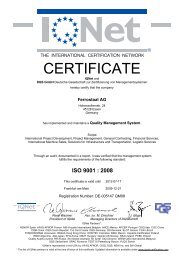
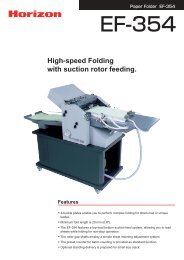
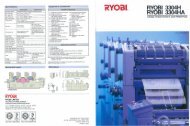
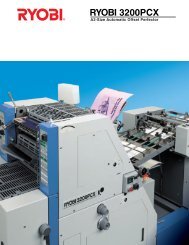
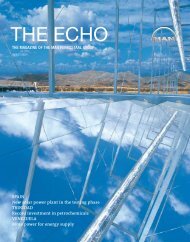

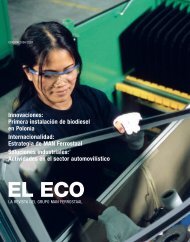





![Product information: Ryobi 3300CR [PDF, 3.1 mb] - Ferrostaal](https://img.yumpu.com/2745806/1/184x260/product-information-ryobi-3300cr-pdf-31-mb-ferrostaal.jpg?quality=85)